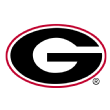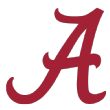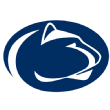Less than three weeks remain until the College Football Playoff field is set, but few would quibble with the top three teams right now.
Top-ranked LSU and No. 2 Ohio State have separated themselves all season, and No. 3 Clemson has looked more like a defending champion after a September scare at North Carolina. If all three win out, they'll occupy three of the spots in the final ranking. That brings us to what's shaping up to be the biggest question in the sport: Who's No. 4?
After Week 12, here are the six teams with the best chance to be No. 4 come Dec. 8.
You already know the résumés, but judging strictly by what has happened on the field, here's a case for and against each team, with some intel from coaches, heading into the stretch run.

Georgia (9-1)
CFP ranking: No. 4
Remaining schedule: Saturday vs. Texas A&M, Nov. 30 at Georgia Tech
The case for Georgia: In a year in which offenses are stealing the spotlight in the SEC, Georgia is driven by defense. The Bulldogs entered Saturday's game at Auburn as the last FBS team yet to allow a rushing touchdown (Auburn broke the streak, rushing for one score). Georgia has allowed only 12 total touchdowns through the first 10 games.
Coaches say first-year coordinator Dan Lanning has added new pressure elements to Kirby Smart's scheme. Without a dominant pass-rushing lineman, Georgia has 22 sacks and 55 tackles for loss, on pace to surpass last season's totals (24 sacks, 65 TFLs).
"He brings more twist game. He moves the front more," a Power 5 offensive coordinator said of Lanning. "Basically, he's more aggressive than the traditional Saban tree on base downs, and he will pressure your ass with good players."
Georgia recently has shown more aggressiveness on offense, recording 10 plays of 25 yards or longer in its past three games after just two total against South Carolina (loss) and Kentucky (win).
"Their offensive line's really well-coached and really talented," a Power 5 defensive coordinator said. "The backs are talented, the quarterback's talented, the receivers have gotten better each week."
The case against Georgia: Despite recent big-play flashes, can the Bulldogs' offense be trusted, especially when it faces an opponent with legitimate firepower, like LSU?
"They hadn't really played a good offense," an SEC coordinator said. "They've played two or three backup or third-team quarterbacks. Other than [Lawrence] Cager, their receivers don't have a lot of reps. They miss [Mecole] Hardeman and [Terry] Godwin."
Although Georgia's offense has produced decently against talented defenses like Auburn and Florida, it has eclipsed 30 points just once in the past seven games. The Bulldogs were outgained 329-251 on Saturday and averaged only 3.9 yards per pass. An inefficient second half nearly cost Georgia at Auburn.
"Something's off," an SEC secondary coach said.
"I think that they're missing the guy calling it last year [Jim Chaney, now at Tennessee]," an opposing defensive coordinator added. "It doesn't look the same."

Alabama (9-1)
CFP ranking: No. 5
Remaining schedule: Saturday vs. Western Carolina, Nov. 30 at Auburn
The case for Alabama: Before Saturday's painful win at Mississippi State, when quarterback Tua Tagovailoa sustained a season-ending hip injury, coaches were nearly unanimous in labeling Alabama's roster as worthy of making the top four. The Tide's talent remains, even without Tagovailoa.
Alabama still boasts arguably the nation's best receiving corps, a powerful offensive line, elite-level defenders and the best coach in modern college football history.
"Offensively, what they have, those receivers are, wow," a Power 5 defensive coordinator said. "Everybody they have at receiver is ridiculous."
Even with backup Mac Jones at quarterback, Alabama is capable of striking quickly and often. After a 21-point fourth quarter in last week's loss to LSU, Alabama scored five touchdowns in the first 24 minutes at Mississippi State. Tennessee is the only team to hold Alabama to less than 448 yards.
"Offensively, they're a notch above," an SEC defensive assistant said. "They've got elite talent on the outside."
The case against Alabama: Tagovailoa's injury dramatically changes things, especially because Alabama leans on its offense so much. Although Jones looked solid against Arkansas and Mississippi State, the offense functions differently without No. 13.
"Alabama without Tua is average at best," an FBS coach said.
Alabama's defense still can shut down offenses, but there have been enough cracks -- 324 pass yards allowed to South Carolina, 279 rush yards allowed to Ole Miss, 559 total yards allowed to LSU -- to validate the doubt coaches cast before the season.
Alabama misses linebacker Dylan Moses, who suffered a season-ending knee injury in August. Last week's defensive depth chart included four freshman starters in the front seven. Alabama has started an FBS-high six freshmen on defense.
"They got a little too young over there for various reasons," an SEC coordinator said.
A Power 5 coordinator said the shuffling on Saban's coaching staff has led to some misses in recruiting.
"The recruiting rankings are one thing, but actually signing the best players are another," the coach said. "When you have that turnover, you know you're not coaching them, so you're not signing the best players. You're signing the highest-ranked players."

Oregon (9-1)
CFP ranking: No. 6
Remaining schedule: Saturday at Arizona State, Nov. 30 vs. Oregon State
The case for Oregon: Oregon looks the part, with a roster that matches up along the line of scrimmage and at most of the perimeter positions. Coach Mario Cristobal, a longtime offensive line coach, has assembled an athletic, powerful and experienced front five.
"The strength is their O-line," a Pac-12 defensive coordinator said. "They're going to get a yard no matter what on that run scheme. Those guys just surge and move you off the ball, well-coached, got a lot of NFL guys up front there."
Several coaches consider sophomore left tackle Penei Sewell as the nation's top young lineman. "Penei is a top pick in the NFL right now," one said.
Speaking of first-round talents, quarterback Justin Herbert looks like one, passing for 2,662 yards and 28 touchdowns with only three interceptions.
"He's the best I've been around," Cristobal told me last week. "I've never seen a guy with that kind of ability and intellect, that kind of want-to. He has taken over football games."
Oregon also has balance with an improved defense under first-year coordinator Andy Avalos. The Ducks are 10th nationally in points allowed, eighth in interceptions per pass attempt and second in red zone touchdown percentage allowed.
"Last year, we were probably ninth, 10th or 11th [in the Pac-12] in most categories, and we lost three guys drafted by the NFL," Cristobal said. "Andy was the perfect fit to tie the back end to the front end and maximize our talent."
The case against Oregon: Like all CFP contenders, the Ducks have dominating performances -- 45-3 over Colorado, 56-24 over USC, 34-6 over Arizona. But they also failed to score in the first half against Cal before prevailing 17-7. They beat Washington and Washington State (combined record of 11-9) by a total of six points.
Oregon's wide receivers became a story in 2018 because of dropped passes (52). The group has played cleaner this fall, but there's still no alpha. Tight end Jacob Breeland likely would be the team's receiving yards leader if he didn't sustain a season-ending leg injury last month.
"We didn't think their receivers were great," a Pac-12 coordinator said. "It's not like any of the three from USC."
Another Pac-12 coach noted that Oregon's offense has a tendency to stall, as shown in the second half against Auburn and the first half against Cal. There's a question of whether the Ducks can out-scheme teams with equal or better talent.
"They're not very diverse on offense," the coach said. "I think that will always hold 'em back a little bit."

Utah (9-1)
CFP ranking: No. 7
Remaining schedule: Saturday at Arizona, Nov. 30 vs. Colorado
The case for Utah: Utah is balanced, consistent and often dominant. An experienced defense features star power at all three levels, as linebackers Devin Lloyd and Francis Bernard have emerged this fall.
Utah leads the nation in rush defense and ranks in the top four nationally in yards allowed, yards per play allowed, points allowed and first downs allowed. The Utes have two shutouts and two games in which they have allowed just a field goal.
"That D-line, oh man," a Pac-12 coordinator said. "They've got a lot of guys who will be playing on Sunday for sure."
Stout defense is the standard at Utah, but the offense's improvement has elevated the ceiling for the season.
Quarterback Tyler Huntley and running back Zack Moss propel the Pac-12's top rushing offense (207.1 YPG). Huntley has been the league's most efficient passer, completing 74.2% of his passes for 13 touchdowns and only one interception.
"Their quarterback is the MVP of the league," a Pac-12 defensive coordinator said. "He's a difference-maker."
First-year offensive coordinator Andy Ludwig told me Huntley is "everything you're looking for in a senior quarterback," digesting a scheme that combines Ludwig's concepts and what Utah used previously under Troy Taylor. Huntley is showing greater willingness to stay in the pocket, which helps in games in which Utah needs to throw to win. At Washington, he converted several key third downs through the air.
"Watching film of him as a junior and a sophomore, he would be quick to pull the ball down and try to make a play with his feet," Ludwig said. "Now I see him developing the ability to slide in the pocket, buy a little time and really look to get the ball thrown downfield.
"The Washington game really helped our confidence."
The case against Utah: Playoff teams have to deliver when the lights are brightest. Utah's loss Sept. 20 at USC raised red flags that could resurface in a potential Pac-12 championship matchup against Oregon.
The Utes were uncharacteristically undisciplined, committing 16 penalties for 120 yards. They faced essentially a one-dimensional USC offense but couldn't stop a third-string quarterback (Matt Fink) and a passing game that often resembled three flies up.
"That was the lesson: You better not leave a one-on-one out there," said a defensive coordinator who faced USC. "Utah stayed in their base structures. Just couldn't make the plays over the top."
Utah spent almost the entire game in USC territory, and outgained the Trojans 457-381, but scored just 23 points.
"For whatever reason, Kyle hasn't beaten them there," a Pac-12 coach said, noting coach Kyle Whittingham's struggles at the Los Angeles Coliseum. "Sometimes when that happens, people freak out."
Utah can't afford to freak out again. Although the Utes are consistently stout against the run, they allowed a combined 684 pass yards and seven touchdowns against the two most talented teams they have faced (USC and Washington). Oregon's Herbert is more than capable of putting up similar numbers in the Pac-12 championship game.

Penn State (9-1)
CFP ranking: No. 9
Remaining schedule: Saturday at Ohio State, Nov. 30 vs. Rutgers
The case for Penn State: Penn State has standouts on both sides of the ball, especially on a defense that often looks like the best in James Franklin's tenure. The Lions have two proven pass-rushers in ends Yetur Gross-Matos and Shaka Toney, and powerful, rangy linebackers in Micah Parsons and Cam Brown.
PSU is dominant against the run (75.9 YPG allowed) and lives in the backfield (33 sacks, 76 tackles for loss).
"Their length on defense is something we rarely see, especially the second level, those linebackers," an opposing head coach said. "We don't see those types of defensive ends, either."
Despite losing record-setting quarterback Trace McSorley, PSU's offense continues to roll. Quarterback Sean Clifford can stretch the field (37 completions of 20 yards or more) with wideout KJ Hamler and Pat Freiermuth, arguably the nation's best tight end. Running backs Noah Cain and Journey Brown are both solid contributors.
"He's got a swagger about him," an FBS coach said of Clifford. "The tight end's impressive, they've got a couple receivers. Hamler is pretty special."
The case against Penn State: There are limitations that surfaced in PSU's lone loss at Minnesota and even in some of its wins. While the defensive front seven jumps out, PSU drops off in the secondary. Coaches say the Lions miss high-level talents like Amani Oruwariye, Grant Haley and Christian Campbell.
Penn State struggled with Minnesota's run-pass option, even though it practices against an RPO-heavy offense. The Lions have allowed 710 pass yards and four touchdowns in their past two games.
"They kind of got exposed a little bit," a Big Ten coach said. "Their D-line is really their strength and their front seven. [Minnesota] neutralized all that, got the ball out fast, and Penn State had no answers."
The Lions' offense has a tendency to go cold, especially when Clifford gets shaky. They averaged 24.3 points and 293 yards during a three-game stretch against Iowa, Michigan and Michigan State, and left points on the field in the first half at Minnesota.
"You stop the tight end, you stop Hamler, you stop the run, you've got a shot," a Big Ten defensive assistant said. "They miss a true [No. 2] receiver to take the pressure off Hamler."

Oklahoma (9-1)
CFP ranking: No. 10
Remaining schedule: Saturday vs. TCU, Nov. 30 at Oklahoma State
The case for Oklahoma: The Sooners won't run the table in the Big 12, but coaches think they're the league's most talented team. A historic comeback Saturday at Baylor, even without superstar wideout CeeDee Lamb, shows how dangerous OU can be when the offense is clicking.
OU leads the nation in yards per pass attempt (11.7), while ranking second in yards per rush (6.5). No other offense boasts the same type of big-play balance.
"They throw so much at you," a Power 5 defensive coordinator said. "To get your numbers right to defend those guys [in the run game] is hard, and then you need to defend the pass on top of that. They're so damn good."
While quarterback Jalen Hurts' numbers jump out, Lamb is the player who has coaches buzzing.
"He has incredible vision and ability to start and stop, and go left and go right, and spin around," a Big 12 secondary coach said. "Not quite like a fast guy, but somehow he eludes defenders and scores in the open field time after time."
A Power 5 defensive coordinator added: "That dude's got to be the best wideout in the country, hands down."
First-year defensive coordinator Alex Grinch has upgraded one of the nation's weakest units. OU is rarely dominant but can make timely stops and takeaways, as it showed at Baylor.
The case against Oklahoma: Although Hurts plays freer in coach Lincoln Riley's offense than he did at Alabama, he also has become more turnover-prone. He had two red zone turnovers (and nearly a third) against Texas, and three more against Baylor, including a goal-line fumble.
Hurts' overall numbers are terrific -- 3,039 pass yards, 983 rush yards, 43 touchdowns (28 pass, 15 rush) -- but some coaches view him more as an athlete than a pure passer.
"I still have reservations about Hurts," a Power 5 defensive coordinator said. "Lincoln does a good job of making his quarterbacks successful -- easy reads, getting the ball out. The system definitely helps him."
Kansas State showed how to beat Oklahoma's system, pounding the ball on the ground (213 yards on 45 carries) and holding the ball (38:08). Iowa State's big fourth quarter (20 points) nearly led to a road upset, and OU no-showed in the first half at Baylor. Although Grinch has instilled a better mindset on defense, he still has only a handful of consistent playmakers (linebacker Kenneth Murray, linemen Ronnie Perkins and Neville Gallimore).
Week 12 notes
Eliah Drinkwitz entered a great situation at Appalachian State, which went 41-11 in the four seasons before his arrival, with three Sun Belt titles (outright or shared).
Still, before their win over North Carolina on Sept. 21, Appalachian State hadn't beaten a Power 5 opponent since its historic upset of Michigan in 2007. With their victory over South Carolina on Nov. 9, the Mountaineers are the first Sun Belt team with two wins over Power 5 opponents in a season. There are other milestones: first Sun Belt team to start 7-0, first Sun Belt team ranked in the AP top 20, first Sun Belt team to win as a Top 25 team.
"By nature, this place is built on competitiveness," Drinkwitz said. "We all feel a little bit slighted, whether it's because we're not at a Power 5 school or we were under-recruited. They're trying to prove their worth every day. Now you give them a target to shoot for, they go achieve it. They're underdogs."
Appalachian State's next target is clinching a division title. Although the Mountaineers would need help to finish as the highest-rated Group of 5 team, they understand what they've done.
"You have to take a moment in time and appreciate it," Drinkwitz said. "It's the first time in the history of the Sun Belt to have a team ranked. But then you also have to put it away and go back to work."
Virginia Tech looked like a program in complete crisis after a 35-point home loss to Duke on Sept. 27. After a rough 2018 season, which ended with some players reportedly encouraging others to lose the finale to prevent a bowl appearance, the Hokies mostly stumbled through September. Many questioned the program's direction under fourth-year coach Justin Fuente.
Seven weeks later, the Hokies (7-3) are rolling. They are 5-1 since the Duke game, the lone defeat a one-point loss to Notre Dame, which had to rally in the final minute. After a 30-point second half propelled Virginia Tech to a win over 7-1 Wake Forest, the Hokies followed with a 45-0 victory Saturday at Georgia Tech.
"The meeting we had [after the Duke loss], I just put it up there and told them it was my fault," Fuente said recently. "I told them, 'We are not a tough football team right now, we're not mentally tough, we're not emotionally tough, and we didn't play physically tough. Here's examples of it on the film and this is not your fault. This is my fault, and it's changing right now.'"
This could turn out to be a seismic stretch for Fuente, who clearly struggled with some areas of the locker room he inherited from Hall of Famer Frank Beamer. Virginia Tech has its first four-game win streak in ACC play since 2011 and can win the Coastal Division with wins over Pitt and Virginia.
"I just told them, 'We're never going back to that. Doesn't mean we're going to win every game, but we're not putting that on the field anymore,'" Fuente said. "I know I had [gone away] from the way we went about things. The way we went about things was different than what I had always done, and that's my fault. So I quit worrying about all that other stuff and worried about getting our guys ready to play."
